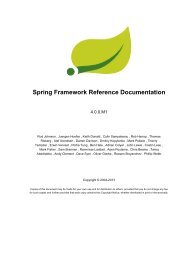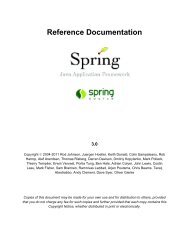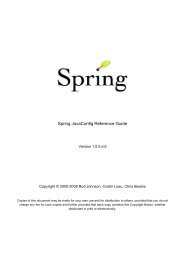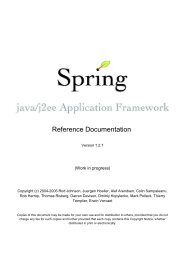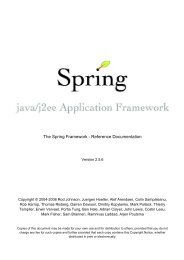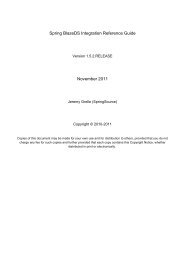Spring JavaConfig Reference Guide - Spring Web Services - Parent ...
Spring JavaConfig Reference Guide - Spring Web Services - Parent ...
Spring JavaConfig Reference Guide - Spring Web Services - Parent ...
Create successful ePaper yourself
Turn your PDF publications into a flip-book with our unique Google optimized e-Paper software.
Creating and using bean definitionsAs <strong>JavaConfig</strong> encounters the VisibilityConfiguration class, it will create 3 beans : publicBean,hiddenBean and secretBean. All of them can see each other however, beans created in the 'owning' applicationcontext (the application context that bootstraps <strong>JavaConfig</strong>) will see only publicBean. Both hiddenBean andsecretBean can be accessed only by beans created inside VisibilityConfiguration.Any @Bean annotated method, which is not public (i.e. with protected or default visibility), will create a'hidden' bean. Note that due to technical limitations, private @Bean methods are not supported.In the example above, mainBean has been configured with both publicBean and hiddenBean. However, sincethe latter is (as the name imply) hidden, at runtime <strong>Spring</strong> will throw:org.springframework.beans.factory.NoSuchBeanDefinitionException: No bean named 'hiddenBean' is defined...To provide the visibility functionality, <strong>JavaConfig</strong> takes advantage of the application context hierarchyprovided by the <strong>Spring</strong> container, placing all hidden beans for a particular configuration class inside a childapplication context. Thus, the hidden beans can access beans defined in the parent (or owning) context but notthe other way around.4.2.4. Bean scoping4.2.4.1. Using @Bean's scope attribute<strong>JavaConfig</strong> makes available each of the four standard scopes specified in Section 3.4, "Bean Scopes" of the<strong>Spring</strong> reference documentation.The DefaultScopes class provides string constants for each of these four scopes. SINGLETON is the default,and can be overridden by supplying the scope attribute to @Bean annotation:@Configurationpublic class MyConfiguration {@Bean(scope=DefaultScopes.PROTOTYPE)public Encryptor encryptor() {// ...}}4.2.4.2. @ScopedProxy<strong>Spring</strong> offers a convenient way of working with scoped dependencies through scoped proxies. The easiest wayto create such a proxy when using the XML configuration, is the element. <strong>JavaConfig</strong>offers as alternative the @ScopedProxy annotation which provides the same semantics and configurationoptions.If we were to port the the XML reference documentation scoped proxy example (see link above) to <strong>JavaConfig</strong>,it would look like the following:(1.0.0.m4-SNAPSHOT)








